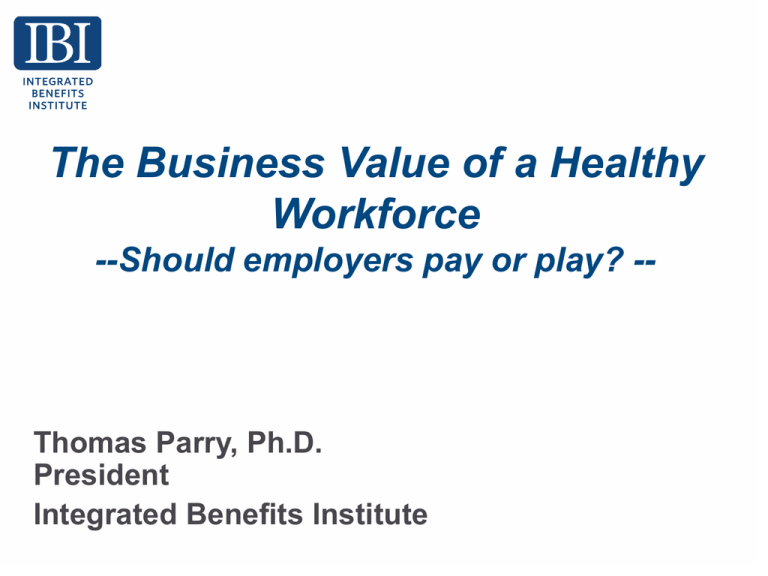Should employers pay or play? - Kentuckian Health Collaborative
advertisement

The Business Value of a Healthy Workforce --Should employers pay or play? -- Thomas Parry, Ph.D. President Integrated Benefits Institute Todays agenda • The old vs. the new model of health • What’s really at risk for employers? • What’s the evidence say? • Can we convince the CFO? • Oh, yeah, what about the data? • What does it mean for employers to pay or play? New Employer Realities • Show the C-suite the value of improved workforce health • Healthcare reform: the value of a healthy workforce or the cost of healthcare? • Dead end: attempting to control claims costs in separate program silos • Looking for best strategies to improve workforce health, reduce lost time and enhance productivity • Limited data, time and dollars The Old Model of Health Plan Design Medical Treatment Claims Costs The New Model of Health Health Behaviors Business Impacts Health Risks Plan Design Health Conditions Work Absence Work Performance Medical Treatment Claims Costs What’s at Risk for Employers? The True Costs of Health • 10,000 life manufacturing company • 70% male • 25% of employees 55 years or older • 62% skilled/semi-skilled laborers Health Costs – The “Traditional” View Health Costs – The “Integrated” View Health Costs – Adding Absence Health Costs – Adding Lost Productivity Quantifying Financial Lost Productivity* • Lost productivity – “the financial impact on a company when employees are not at work and fully functioning” • Two components: absence and decrements in job performance (“presenteeism”) • The Financial Impact of Absence Wage replacement payments “Opportunity costs” of ER’s response • The Financial Impact of Presenteeism Wage and benefit “overpayments” Opportunity costs of resulting lost time ** Source: Sean Nicholson, Mark Pauly, et al., "Measuring the Effects of Work Loss on Productivity with Team Production," Health Economics 15: 111-123 (2006). 12 Full Cost Components 28% 48% 16% Linking Healthcare to Productivity Outcomes Going Beyond Medical & Pharmacy to Absence and Presenteeism $400,000 Cost per 1000 EEs $350,000 $300,000 $250,000 $200,000 $150,000 $100,000 $50,000 $0 Medical Pharmacy Absence lost prod Presenteeism lost prod Co-Morbidity and Lost Time Top 10 Health Conditions by Category Medical Pharmacy Medical & Pharmacy Productivity Total Cost 1 Other Cancer GERD Other Cancer Depression Depression 2 Back/Neck Pain Diabetes Back/Neck Pain Obesity Obesity 3 Other Chronic Pain Hypertension Other Chronic Pain Anxiety Arthritis 4 Coronary Heart Disease Arthritis Depression Arthritis Back/Neck Pain 5 Depression Allergy Coronary Heart Disease GERD Anxiety 6 Sleeping Problem Depression Arthritis Allergy GERD 7 Arthritis Asthma Diabetes Hypertension Allergy 8 Skin Cancer Anxiety Hypertension Back/Neck Pain Other Cancer 9 Diabetes Migraine GERD Sleeping Problem Other Chronic Pain 10 Obesity Osteoporosis Sleeping Problem Fatigue Hypertension Impact of Co-Morbid Conditions on Lost Time 25 Absenteeism Presenteeism 20 Days Lost Per Year 11.1 15 13.1 9.8 9.9 10 12.2 13.0 5 7.2 0 1.9 Single 7.6 6.9 7.8 Single Comorbid Single Comorbid Headache Headache Other Chronic Pain Other Chronic Pain 0.7 Comorbid Depression Depression The CFO’s View of Health MGM Mirage Case Study IBI Health & Productivity Snapshot Results 6.2 lost days per FTE/Year 1.8 lost days per FTE/Year Lost worktime = 8 days per FTE/Year or $2,598 per FTE/Year in Lost Productivity Lost-Time Improvement’s Impact on EBIDTA Reducing 1 lost day/FTE = $15 MM to EBIDTA* from Productivity Gains *Earnings before Interest, Depreciation, Taxes and Amortization The Bottom Line One Day of Productivity Improvement Savings $15.0 MM Wall-Street Multiple 10.7X Outstanding Shares 284.3 M Gain in Stock Price $ .56/share Principal Owner (56%) $90 MM IBI Research: Making Health the CFO’s Business Key Findings CFOs are key participants in benefits decision making Health is an organizational priority Productivity is critical to bottom line but the role of health is less clear CFOs understand health impacts financial performance Internal information is most credible but critical information is lacking CFOs suggest ways to measure productivity Health’s Link to Financial Performance What’s “Very Important” to Workforce Productivity Health Strength of Health Culture If You Work in a Health-Focused Culture • Improving health is seen as very important to productivity • Health’s impact on business goes beyond healthcare costs and includes sick leave, “opportunity costs” of health, turnover, and absence payments • Broader information available to make investment decisions: EE satisfaction, health risks, performance impact, ROI Linking Health & Financial Performance: Putting Results in the CFO’s Terms • • • • • Healthcare costs Sick days Turnover “Opportunity costs” Absence payments Broad Information is Useful … But Not Very Available The Challenge of “Big Data” to Employers The Three Key Data Questions for Employers • What – What is the total health experience of the population of my employees? • Where – Where in the organization are results coming from and what needs our attention? • How – how can I take action to improve my results? Workforce Key Health Dimensions* Financial (cost) Program participation Biometric screening Health risks Utilization Preventive care Chronic conditions Lost worktime Lost productivity Employee engagement * Thomas Parry and Bruce Sherman, A Pragmatic Approach for Employers to Improve Measurement in Workforce Health and Productivity, Population Health Management, Vol. 15, No. 2, 2012 Dimensions & Dashboard Metrics Dimension Summary Metric Financial Program cost/EE Program participation EEs participating/All EEs Biometrics EEs reaching target/All EEs Health risks # of health risks/EE Utilization # EEs getting care/All EEs Preventive care # EEs getting screened/All EEs Chronic conditions # EEs w/ chronic conditions/All EEs Lost worktime # of lost workdays/EE Lost productivity Lost productivity $/EE Employee engagement Engagement score/EE The Temporal Dimension Leading indicators Health risks Biometrics Chronic condition prevalence Treatment indicators Preventive care EE engagement Health services utilization Program participation Lagging indicators Financial Lost worktime Lost productivity Thinking about Metrics as Hierarchies Dashboard metrics Component metrics Contributing metrics Dimension: Lost Work Time Health Dimension Lost worktime Dashboard Metric Component Metrics Contributing Metrics Dimension: Lost Work Time Health Dimension Dashboard Metric # of lost days/EE Component Metrics Contributing Metrics Dimension: Lost Work Time Health Dimension Dashboard Metric Component Metrics Incidental absence days/EE LTD lost days/EE WC lost days/EE Reduced performance days/EE STD lost days/EE Contributing Metrics Dimension: Lost Work Time Health Dimension Dashboard Metric Component Metrics Contributing Metrics Incidence/100 EEs Ave. duration/claim Median duration/claim For more information: Thomas Parry tparry@ibiweb.org 415-222-7282















